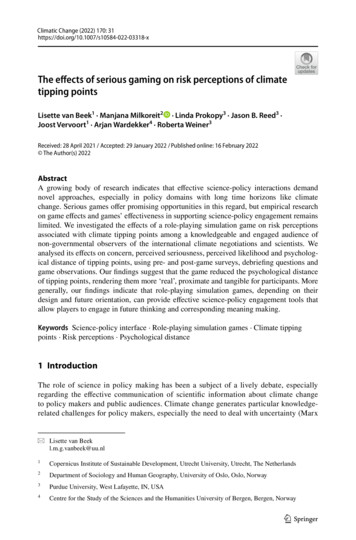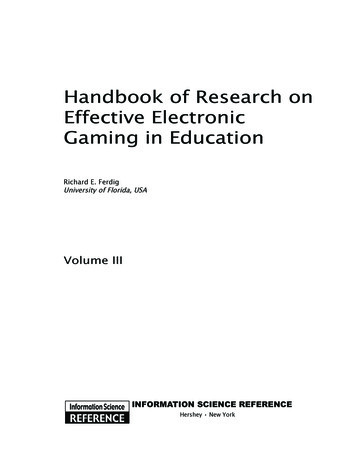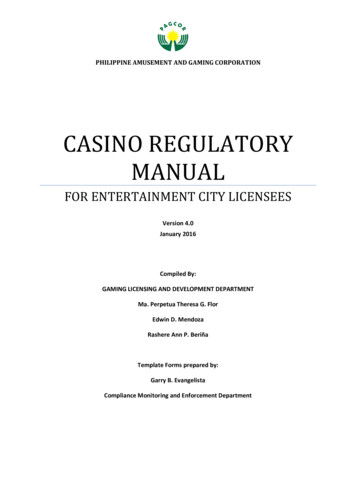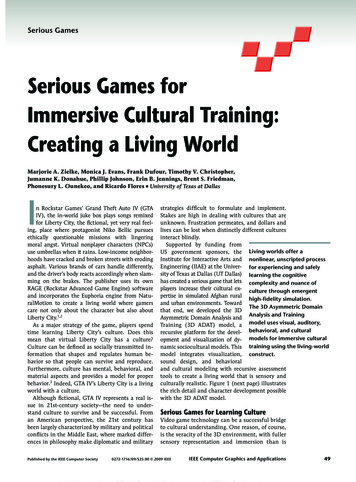
Transcription
Climatic Change (2022) 170: 31https://doi.org/10.1007/s10584-022-03318-xThe effects of serious gaming on risk perceptions of climatetipping pointsLisette van Beek1 · Manjana Milkoreit2 · Linda Prokopy3 · Jason B. Reed3 ·Joost Vervoort1 · Arjan Wardekker4 · Roberta Weiner3Received: 28 April 2021 / Accepted: 29 January 2022 / Published online: 16 February 2022 The Author(s) 2022AbstractA growing body of research indicates that effective science-policy interactions demandnovel approaches, especially in policy domains with long time horizons like climatechange. Serious games offer promising opportunities in this regard, but empirical researchon game effects and games’ effectiveness in supporting science-policy engagement remainslimited. We investigated the effects of a role-playing simulation game on risk perceptionsassociated with climate tipping points among a knowledgeable and engaged audience ofnon-governmental observers of the international climate negotiations and scientists. Weanalysed its effects on concern, perceived seriousness, perceived likelihood and psychological distance of tipping points, using pre- and post-game surveys, debriefing questions andgame observations. Our findings suggest that the game reduced the psychological distanceof tipping points, rendering them more ‘real’, proximate and tangible for participants. Moregenerally, our findings indicate that role-playing simulation games, depending on theirdesign and future orientation, can provide effective science-policy engagement tools thatallow players to engage in future thinking and corresponding meaning making.Keywords Science-policy interface · Role-playing simulation games · Climate tippingpoints · Risk perceptions · Psychological distance1 IntroductionThe role of science in policy making has been a subject of a lively debate, especiallyregarding the effective communication of scientific information about climate changeto policy makers and public audiences. Climate change generates particular knowledgerelated challenges for policy makers, especially the need to deal with uncertainty (Marx* Lisette van Beekl.m.g.vanbeek@uu.nl1Copernicus Institute of Sustainable Development, Utrecht University, Utrecht, The Netherlands2Department of Sociology and Human Geography, University of Oslo, Oslo, Norway3Purdue University, West Lafayette, IN, USA4Centre for the Study of the Sciences and the Humanities University of Bergen, Bergen, Norway13Vol.:(0123456789)
31 Page 2 of 23Climatic Change (2022) 170: 31et al. 2007), understand complex-system dynamics, imagine possible long-term futures(Milkoreit 2015, 2019) and assess different solutions and their long-term impacts(Tàbara et al. 2017). Communicating these characteristics of climate change is challenging, which can lead to misinterpretations and limit the uptake and use of available information (Enserink et al. 2013; Wardekker et al. 2008). Hence, the complex, uncertainand long-term nature of climate change calls for science-policy communication toolswhich involve multiple forms of experience and representation (Milkoreit 2015).Serious games, in particular role-playing simulation (RPS) games, offer a promising avenue for effective science-policy engagement regarding climate change (Vervoort 2019). In RPS games, participants take on particular roles and interact withothers according to set rules that simulate the outcomes of their interactions. That is,RPS games allow for a ‘safe space’ to experiment with policy responses to complexproblems; to learn interactively about complex system dynamics; to simulate a ‘livedexperience’ of future realities, including the impacts of present decisions and policies;and to explore different perspectives of stakeholders (e.g. Fleming et al. 2020; Rumoreet al. 2016; Sterman et al. 2015). Through this experiential engagement, RPS games canaffect different cognitive and emotional processes of participants, including their knowledge, beliefs and risk perceptions (Meya and Eisenack 2018; Van Pelt et al. 2015).A number of serious games regarding climate change have been developed over thelast decade (Galeote et al. 2021; Flood et al. 2018; Reckien and Eisenack 2013; Wuand Lee 2015), but empirical research on game effects has remained limited. With fewexceptions (e.g. Parker et al. 2016; Onencan et al. 2016), most climate games target layaudiences or students (Galeote et al. 2021; Rumore et al. 2016) rather than policy makers. Correspondingly, research on game effects among policy audiences, i.e. the games’effectiveness as science-policy engagement processes, remains particularly thin. Beginning to fill this gap, we investigated the effects of a RPS game tailored specifically to theneeds and interests of the international climate negotiation community on players’ riskperceptions regarding climate tipping points.We developed a RPS game with the purpose to provide a multi-modal, experientiallearning environment regarding climate tipping points and their relevance for global climate governance. We conducted game workshops with observers of the internationalclimate negotiations (primarily representatives of non-governmental organizations)and scientists and analysed the effects of gameplay on their risk perceptions. While weexplore a range of risk dimensions, we focus, in particular, on psychological distancing,the “subjective experience that something is close or far away from the self, here, andnow” (Trope and Liberman 2010, p. 440).Climate tipping points present an interesting case to study science-policy engagement, because it encapsulates all the challenging characteristics of climate change(uncertainty, complexity, long time horizons), but it has significant additional riskimplications due to their large-scale nature, potential irreversibility and implicationsfor human wellbeing. Moreover, climate tipping points are still largely ignored byinternational policy makers (Milkoreit 2015, 2019) and preliminary evidence suggeststhat risk perceptions regarding tipping points might not match risk realities (Bellamyand Hulme 2011).We discuss key concepts and theories that inform our research design in Sect. 2, concluding with the literature-informed hypotheses. Section 3 (and the supplementary materials) details our methodological approach and challenges, including a description of theRPS game. The results of our quantitative and qualitative analyses are summarized inSects. 4 and 5, respectively. In Sect. 6, we explore the reasons for our findings and seek to13
Climatic Change (2022) 170: 31Page 3 of 23 31explain the differences between the quantitative and qualitative analyses. We conclude withimplications for future research on serious games as science-policy engagement tools.2 Perceptions of climate change risks and role‑play simulation gamesBelow, we review relevant insights of two interdisciplinary research fields that inform ourresearch design: work on factors that influence climate-related risk perceptions among different audiences and research on innovative approaches, including serious gaming, to overcome communication challenges at the science-policy interface.2.1 Perceptions of risks associated with climate changeClimate change risk perceptions have been studied extensively, including their influenceon people’s willingness to engage in pro-environmental behaviours or to support specificpolicies. This large body of work points to a broad set of interrelated variables affectingclimate-related risk perceptions, including knowledge, personal experience of climateimpacts, emotions, cultural worldviews and psychological distancing. Many of these variables can potentially be influenced through serious gameplay. Most relevant for our studyare knowledge, emotions and distancing.While several studies have indicated that climate change knowledge is positively relatedto risk perceptions (Milfont 2012; Xie et al. 2019), others point to a more complicated relationship as knowledgeable individuals exist at both ends of the risk perception spectrum(Capstick and Pidgeon 2014; Kahan et al. 2012). Pre-existing beliefs and cultural worldviews may, in fact, be stronger predictors of climate change risk perceptions than knowledge (Kahan et al. 2012; Libarkin et al. 2018).Emotions play an important role in moral judgements of acceptability of risks (Roeser2006, 2012) and have been found to influence moral reasoning of climate negotiation participants (Milkoreit 2015). However, the role of emotions is contentious in the risk perception literature. On the one hand, limited emotional involvement has been offered as anexplanation for the lack of urgency related to climate change. Hence, scholars have arguedfor stronger emotional appeals in climate risk communication (Leiserowitz 2006; Weber2010; Feldman and Hart 2016) and explored the emotional engagement potential of different forms of communication (Gustafson et al. 2020). On the other hand, research hasdemonstrated that messages focusing on specific emotions, especially fear, can be ineffective at best and counterproductive at worst (Ettinger et al. 2021; O’Neill and NicholsonCole 2009). Others point to a complex, sometimes counterintuitive, and nuanced role ofemotions in climate communication, emphasizing the importance of message tailoring tospecific target populations (Chapman et al. 2017).Similar to other environmental risks, perceiving climate change risks involves psychological distancing mechanisms. Psychological distancing in the context of climate changerefers to the tendency to believe that climate change affects people in geographically distant locations and people in the distant future more seriously than those who live close tous in space and time, including ourselves (Leiserowitz 2006; Spence et al. 2012). In addition, climate change is more often perceived as a collective-societal rather than an individual-personal risk (Van der Linden 2015). Uncertainty regarding the types and timing of climate change impacts invites distancing. The idea that we do not know exactly when certain13
31 Page 4 of 23Climatic Change (2022) 170: 31effects will set in allows us to doubt their seriousness and potential impact on our own lives(Jones et al. 2017; Spence et al. 2012).These four dimensions of distancing (geographical, temporal, social, likelihood) buildon construal level theory (CLT; Trope and Liberman 2010), which posits that perceptuallydistant phenomena are construed on a higher, more abstract level and closer phenomenaon a more concrete, contextualized level. These findings are insightful for climate communication: framing climate change as a local rather than global issue, or as an individualrather than societal threat, can reduce the psychological distance (“proximising”; Joneset al. 2017; Loy and Spence 2020). However, CLT has been criticized for having a limitedexplanatory value of climate (in)action, especially because its use neglects the complexcognitive processes of risk processing as well as changes in belief systems (Brügger et al.2016; Brügger 2020).2.2 Perceptions of risks associated with climate tipping pointsAs defined by Lenton (2011, p. 201), “A climate ‘tipping point’ occurs when a smallchange in forcing triggers a strongly non-linear response in the internal dynamics of partof the climate system, qualitatively changing its future state”. Examples of climate tippingprocesses include the bleaching and die-off of coral reefs and the melting of the Greenland Ice Sheet. Key characteristics of tipping-point dynamics include the fundamental reorganization of a system (the tipping element) during its movement from one stable stateto another, the abruptness (i.e. non-linearity) of the change process and the potential irreversibility of these changes on time scales relevant for human decision-making. There is ahigh degree of uncertainty regarding their timing and impacts as well as social responsesto tipping points (Dessai and Van der Sluijs 2007). Recent evidence suggests that tippingpoints may be closer than previously thought (Lenton et al. 2019). Hence, climate scientistsrepeatedly stress the urgency of stricter climate policies and stronger mitigation efforts toprevent future tipping processes in the climate system (Lontzek et al. 2015).These characteristics, especially non-linearity and uncertainty regarding the time oftheir occurrence, pose a number of risk perception challenges (Sterman 2011). Humansusually perceive time and causation in a linear fashion and have difficulty perceiving nonlinear temporal and causal dynamics (Dessai and Van der Sluijs 2007; Chi and Roscoe2002), often lack cognitive skills to understand the behaviour of complex systems (Plate2010; Milkoreit 2015) and face difficulties making sense of sudden, rapid and exponentialchanges (Pereira and Viola 2018). The relevant time horizons of climate tipping—rangingfrom years to millennia—present particular challenges for the human mind and for environmental governance (Galaz 2019). There is also emotional resistance to dealing with tipping points because it might cause anxiety, fear and feelings of powerlessness (Milkoreit2015). Further, the availability heuristic limits the imagination of possible futures resultingfrom triggering climate tipping points: such counter-intuitive futures require informationthat is not readily available in people’s memories (Pahl et al. 2014). Making sense of suchcounter-intuitive future states should therefore involve the active and systematic ‘imaginingthe unimaginable’ (Dessai and Van der Sluijs 2007).The literature specific to risk perceptions regarding tipping points is very limited andbased exclusively on empirical research with lay audiences. Bellamy and Hulme (2011)found that their study participants were less concerned about tipping points comparedto climate change in general. While tipping points were perceived as dangerous, study13
Climatic Change (2022) 170: 31Page 5 of 23 31participants considered them unlikely1 and expected them to pose risks only to distant,developing countries and in the long-term future. A second study (Lowe et al. 2006) investigated changes in risk perceptions after seeing the movie ‘The Day After Tomorrow’,which used a narrative of extremely rapid climate change similar to a tipping-point scenario. After watching the movie, participants were more concerned about climate changebut perceived abrupt climate changes as less likely and more temporally distant. Theresearchers explain this result by the fact that the movie is science fiction, creating disbelief among participants. The findings from these limited studies imply that distancing is acrucial mechanism in forming risk perceptions of climate tipping points. Based on thesesomewhat dated but highly relevant findings, we expected that psychological distancingmechanisms would play a particularly strong role in risk perceptions associated with climate tipping points in our study.2.3 Role‑play simulation games for science‑policy engagementSerious games, i.e. games with an educational purpose, have a long history in policy settings and decision support, because of their ability to simulate the implementation of policies and regulations, which enables the anticipation of their (unintended) effects (Mayer2009). Simulation games are a particular type of serious game that have been used sincethe 1960s when researchers and policy makers started to realize the possibilities of combining computer simulations with human agency. They can support science-policy engagement regarding complex systems, as they allow players to experience the dynamics ofsocial-environmental systems, and the impacts of their decisions over various time horizons (Alessi and Kopainsky 2015).Recognizing these capacities, simulation games have been applied in various environmental policy domains, such as water management (Zhou and Mayer 2018) and urban sustainability (Mangnus et al. 2019). A large and growing number of games are aimed specifically at climate change engagement (Flood et al. 2018; Galeote et al. 2021; Reckien andEisenack 2013; Wu and Lee 2015), potentially offering a science communication approachthat is complementary to and supportive of scientific assessment reports. Most prominentamong these simulation games is the World Climate Simulation (Sterman et al. 2015).Other examples of (role-play) simulation games include Sustainable Delta (Van Pelt et al.2015), WeShareIt (Onencan et al. 2016) and CAULDRON (Parker et al. 2016). Rather thanpresenting scientific information to policy makers in written, visual and verbal forms, serious gameplay arguably involves richer, multi-modal engagement with the scientific information on possible futures, including more emotional, tactile, interactive and experientialforms of engagement (Candy and Dunagan 2017).A vast body of literature on the effects of serious climate games suggests an array ofpotential cognitive, affective and behavioural effects, including learning about complexsystems and increased concern about climate change (Galeote et al. 2021). For example,the World Climate Simulation of the international climate negotiations has been shownto increase knowledge and interest in learning about climate change as well as affective engagement with the topic (Rooney-Varga et al. 2018). A handful of studies on1A measure of perceived likelihood evaluates whether people perceive a future event as unlikely or likely.This is different from the uncertainty dimension of psychological distance which evaluates whether peopleperceive uncertainty regarding climate change is happening and what its causes or impacts are.13
31 Page 6 of 23Climatic Change (2022) 170: 31simulation games specifically demonstrated influence on perceptions of environmentalrisks (Rebolledo-Mendez et al. 2009), including increases in concern (Rumore et al. 2016)and improved understanding of uncertainty (Van Pelt et al. 2015). Apart from these studies,the empirical evidence of the effectiveness of RPS games remains scarce.Given this growing evidence on the specific strengths of RPS games, they provide apromising toolset for science-policy engagement regarding climate tipping points. Theycan immerse players in creating and experiencing possible pathways into the future, bringing to life scenarios that are challenging to imagine (Vervoort 2019). Games can providea safe space for experimenting with decision-making strategies regarding tipping points(Flood et al. 2018; Meya and Eisenack 2018). The iterative feedbacks between playerdecisions and game behaviour combined with the game’s ability to compress time enableparticipants to better understand the complex, non-linear and abrupt dynamics of the climate system over time (Meya and Eisenack 2018; Plate 2010). Moreover, players can gaininsights into other players’ beliefs and perceptions regarding tipping-point risks throughtheir role-play interactions, which can improve their understanding of the governance challenges involved (Rumore et al. 2016; Valkering et al. 2013).Our study draws on the literatures reviewed above to study the impacts of a RPS gamedesigned to engage members of the international climate governance community in alearning process about climate tipping points. Drawing on prior findings in this literature,especially regarding knowledge, multi-modal engagement and psychological distancing,we hypothesized that:H1: Gameplay increases concern about climate tipping pointsH2: Gameplay increases perceived seriousness of climate tipping pointsH3: Gameplay decreases psychological distance of climate tipping pointsH3a: Gameplay decreases perceived geographical distance of climate tipping points.H3b: Gameplay decreases perceived social distance of climate tipping points.H3c: Gameplay decreases perceived temporal distance of climate tipping pointsH4: Gameplay increases the perceived likelihood of climate tipping points today.3 Research designAs described in more detail below, we designed a RPS game with the specific purposeof providing a learning environment about climate tipping points for the international climate policy community, including negotiators, non-state actors and scientists. Aiming tomake the RPS game maximally valuable and relevant for this community (see Chapmanet al. 2017 on message tailoring), we had conducted a series of surveys and interviews togauge the existing information and learning needs regarding climate tipping points. Theresults indicated that a high share of climate negotiators (61%), but also members of theNGO community (53%), was unfamiliar with the specific concept of climate tipping points(Milkoreit 2019). Expecting relatively high baseline levels of concern about climate changein general, but nevertheless low levels of knowledge and concern about climate tippingpoints among our game audience, our game design aimed to introduce players to the keycharacteristics of tipping points (esp. their temporal features and their expected impactsover time), to indicate links to climate governance (esp. to global temperature and mitigation) and to make the concept more relatable and relevant.13
Climatic Change (2022) 170: 31Page 7 of 23 313.1 The tipping point negotiations: a role‑play simulation gameWe developed a novel RPS game consisting of two parts: (1) a role-play simulation ofthe international climate negotiations between 2018 and 2043 and (2) a climate fictionstorytelling exercise for the year 2118 (see Supplementary Material I for more details).The second part builds on the results of the first and provides a very different interactionand learning context for participants—formal diplomacy role play vs. informal storydevelopment in a small group.In part 1, participants role-played a simplified version of the United Nations Framework Convention on Climate Change (UNFCCC) negotiations with the added negotiation goal of preventing future climate tipping points. Players adopted the roles ofdiplomats, official delegates of UNFCCC member states, who were provided information about the country they represented, including a national budget and a negotiationmandate. Delegates ‘negotiated’ in face-to-face interactions before they made climaterelated spending decisions for the country they represented, allocating national funds tofour categories of action: mitigation, adaptation, negative-emission technology development and international climate finance. Their decisions were entered into a computerinterface, and a simple integrated climate-economy model calculated their cumulativeeffects on the global climate, esp. temperature change and changes in the probabilityof passing climate tipping points, and the global economy over the coming 5-year timeperiod. This information was presented to participants on a large screen after each negotiation round, providing immediate feedback to players regarding the response of theclimate-economy system to their aggregate decisions, which players could use to informtheir negotiation behaviour and action pledges in the next round.Part 1 bears some similarities to the World Climate Simulation (Sterman et al. 2015),i.e. the combination of facilitated international negotiation role-play, entry of playerdecisions into a computer interface and information feedbacks provided by a scientifically rigorous (i.e. realistic) climate-economy model, but differs significantly in itsimplementation of role-play rules, the use of computer simulations and the importantrole of tipping points. Most importantly, it reflects the bottom-up pledge-and-reviewlogic of the Paris Agreement (Falkner 2016), asking players who represent individualcountries to submit action pledges in 5-year intervals. Each round of gameplay represented 5 years in real time and led towards the submission of nationally determinedcontributions (NDCs) by each player/country.Five tipping points were included in the RPS game: coral reef dieback, the collapseof West Antarctic Ice Sheet (WAIS), the collapse of Arctic Summer Sea Ice (ASSI),boreal forest biome shift and changes in the Indian summer monsoon. At the beginning of the RPS game, the coral-reef tipping point has already been passed, two tipping points (WAIS and ASSI) have small (less than 10%) probabilities of occurringand the probability of triggering the two remaining tipping points is zero at the current global temperature level. The probabilities of passing these four tipping pointsincrease throughout the game, depending on players’ decisions and the effects of mitigation spending on global temperature change over time. In each round, the computermodel calculates the current probability of passing a specific tipping point and conducts a digital ‘dice roll’ to determine whether or not a tipping point is triggered. Giventheir trigger temperature ranges, WAIS and ASSI are often triggered during gameplay,but the boreal forest biome shift and the Indian summer monsoon are not. If a tippingpoint is triggered in a negotiation round (including the coral reef dieback), participants13
31 Page 8 of 23Climatic Change (2022) 170: 31representing affected countries receive an offline ‘event card’ for this tipping point ineach following round, detailing the impacts and corresponding costs of the ongoing tipping process on the country.After five rounds, a workshop facilitator guides participants through a reflection on theoutcomes of their negotiations, and the likely implications of the trends they created forthe rest of the century. Then, the game moves to part 2, which consists of a climate fictionstorytelling exercise that involves the imagination of possible futures (the year 2118) thatcould have been created by their collective decisions during their earlier negotiations. Participants step out of their roles as diplomats and are organized into small groups. Groupsdevelop stories of characters experiencing the effects of tipping points in several locationsaround the world. They are provided a story preamble, introducing the location, characterand context, as well as some scientific information about the location’s climate in 2118.The groups share their stories with all workshop participants and engage in a final reflection on the imagined world they created.The game is preceded by an introduction to the science of climate tipping points and anexplanation of the game rules. The workshop concludes with a debriefing session facilitated by a research team member.Supplementary Materials I, II and III contain more details on game design and characteristics, countries and negotiation alliances and the expected effects of specific gamefeatures on participants’ risk perceptions.3.2 Game workshops and participant recruitmentFollowing a well-established approach to studying game effects (van Pelt et al. 2015;Rooney-Varga et al. 2018), we conducted a number of serious game workshops and conducted pre- and post-game surveys with workshop participants to investigate changes invarious dimensions of participants’ risk perceptions. We conducted seven game workshop sessions between May 2018 and December 2019, during which 84 study participantsplayed the game (see Supplementary Material VI). Four workshops took place at the sidelines of UNFCCC negotiation sessions in Bonn (SB48) and Katowice (COP 24), threeworkshops took place during the 2018 and 2019 fall meetings of the American Geophysical Union (AGU) in Washington, D.C. and San Francisco and one was hosted by a university in the fall semester of 2018.Recruitment efforts for these workshops varied depending on context, but usuallyinvolved personal invitation letters emailed to one or two representatives of an organization or country. For the game sessions during SB48, we focused on diplomats and a diverseset of observer organizations (UNFCCC 2017). For the workshops in Washington, D.C.and San Francisco, we approached non-governmental organizations registered as UNFCCCobservers, Congressional staffers and scientists attending the AGU conferences. Recruitment among climate diplomats is generally challenging due to their geographic distribution, time constraints and confidentiality concerns, which provide significant constraintsfor data collection. Only a small share of workshop participants represents this group (8%).The largest group of participants comprised of scientists (37%), followed by NGO representatives (27%). This sectoral make-up of participants is important for the interpretationof our results. Our participants had 21 different nationalities; a majority of them came fromthe USA (46%) and the European Union (23%). Details regarding recruitment and additional demographic information are included in Supplementary Material VI.13
Climatic Change (2022) 170: 31Page 9 of 23 31Targeting a policy community rather than a lay audience presents significant methodological challenges. Given our significant recruitment challenges regarding climate negotiators, our study population (UNFCCC observer groups and scientists) only partly overlapswith the target audience of the game (state delegates, observers and scientists). We interpret our findings with this difference in mind.3.3 Data collection and analysisGame effects were investigated by means of pre- and post-game workshop surveys andobservations during the debriefing of game workshops. In particular, we analysed to whatextent our game was able to affect concern, perceived seriousness, perceived distanceand perceived likelihood of tipping points. Our survey data was supplemented with gameobservations and notes from post-game debriefing sessions.Participants could complete the pre- and post-workshop surveys either online aheadof/after the event or paper-based at the workshop location. Half of the workshop participants completed both surveys and could be included in our analysis (n 42). Among these,scientists were in the large majority (57%), followed by NGO representatives (19%). Ourstudy combined qualitative and quantitative analyses to maximize ins
2.2erceptions of risks associated with climate tipping points P As dened by Lenton (2011, p. 201), "A climate 'tipping point' occurs when a small change in forcing triggers a strongly non-linear response in the internal dynamics of part of the climate system, qualitatively changing its future state". Examples of climate tipping









